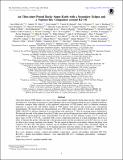Notice
This is not the latest version of this item. The latest version can be found at:https://dspace.mit.edu/handle/1721.1/121206.2
An Ultra-short Period Rocky Super-Earth with a Secondary Eclipse and a Neptune-like Companion around K2-141
Author(s)
Malavolta, Luca; Mayo, Andrew W.; Louden, Tom; Rajpaul, Vinesh M.; Bonomo, Aldo S.; Crossfield, Ian Jm; Buchhave, Lars A.; Kreidberg, Laura; Kristiansen, Martti H.; Lopez-Morales, Mercedes; Mortier, Annelies; Vanderburg, Andrew; Coffinet, Adrien; Ehrenreich, David; Lovis, Christophe; Bouchy, Francois; Charbonneau, David; Ciardi, David R.; Cameron, Andrew Collier; Cosentino, Rosario; Damasso, Mario; Dressing, Courtney D.; Dumusque, Xavier; Everett, Mark E.; Figueira, Pedro; Fiorenzano, Aldo F. M.; Gonzales, Erica J.; Haywood, Raphaëlle D.; Harutyunyan, Avet; Hirsch, Lea; Howell, Steve B.; Johnson, John Asher; Latham, David W.; Lopez, Eric; Mayor, Michel; Micela, Giusi; Molinari, Emilio; Nascimbeni, Valerio; Pepe, Francesco; Phillips, David F.; Piotto, Giampaolo; Rice, Ken; Sasselov, Dimitar; Ségransan, Damien; Sozzetti, Alessandro; Udry, Stéphane; Watson, Chris; ... Show more Show less
DownloadMalavolta_2018_AJ_155_107.pdf (6.498Mb)
Terms of use
Metadata
Show full item recordAbstract
Ultra-short period (USP) planets are a class of low-mass planets with periods shorter than one day. Their origin is still unknown, with photo-evaporation of mini-Neptunes and in situ formation being the most credited hypotheses. Formation scenarios differ radically in the predicted composition of USP planets, and it is therefore extremely important to increase the still limited sample of USP planets with precise and accurate mass and density measurements. We report here the characterization of a USP planet with a period of 0.28 days around K2-141 (EPIC 246393474), and the validation of an outer planet with a period of 7.7 days in a grazing transit configuration. We derived the radii of the planets from the K2 light curve and used high-precision radial velocities gathered with the HARPS-N spectrograph for mass measurements. For K2-141b, we thus inferred a radius of 1.51 ±0.05 R and a mass of 5.08 ±0.41 M, consistent with a rocky composition and lack of a thick atmosphere. K2-141c is likely a Neptune-like planet, although due to the grazing transits and the non-detection in the RV data set, we were not able to put a strong constraint on its density. We also report the detection of secondary eclipses and phase curve variations for K2-141b. The phase variation can be modeled either by a planet with a geometric albedo of 0.30 ±0.06 in the Kepler bandpass, or by thermal emission from the surface of the planet at ∼3000 K. Only follow-up observations at longer wavelengths will allow us to distinguish between these two scenarios.
Department
Massachusetts Institute of Technology. Department of PhysicsJournal
Astronomical Journal
Publisher
American Astronomical Society
Citation
Malavolta, Luca et al. “An Ultra-Short Period Rocky Super-Earth with a Secondary Eclipse and a Neptune-Like Companion Around K2-141.” The Astronomical Journal 155, 3 (February 2018): 107 © 2018 American Astronomical Society
Version: Final published version
ISSN
1538-3881
0004-6256